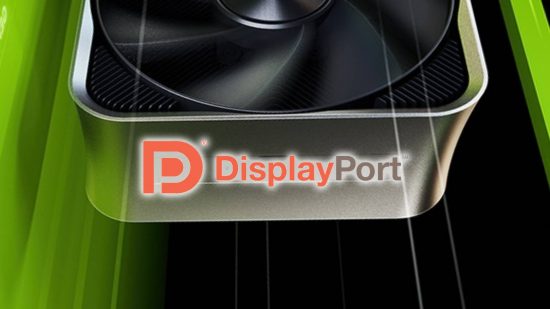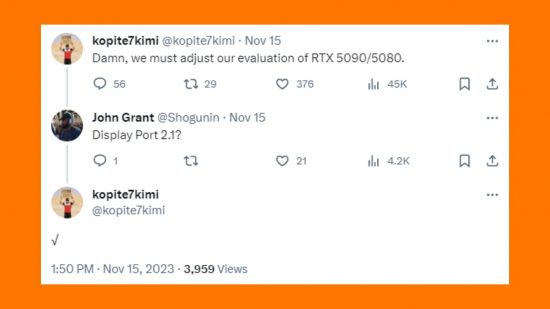When the Nvidia RTX 40 series originally launched, the Lovelace graphics cards lacked Display 2.1 ports, putting them behind in terms of compatibility with other competing graphics cards. This didn’t completely sully the reputation of Team Green at the time, but it has put pressure on when it comes to the inevitable launch of the RTX 50 series. Pressure that Nvidia appears set to yield to.
A great deal of the best graphics cards available today, come with a wealth of ports, including the AMD Radeon 7000 series, which were marketed at launch as having DisplayPort 2.1 compatibility. Support was notably absent when it came to the original launch Nvidia RTX 40 series, but according to a notable Nvidia leaker, the rumored RTX 50 series is going to have DisplayPort 2.1 compatibility from the get go.
On Twitter (X), user kopite7kimi, an individual known for their credible Nvidia related leaks in the past, replied to a comment asking if the RTX 50 series graphics cards will have DisplayPort 2.1 compatibility. When pressed about the Nvidia RTX 5000 series, kopite7kimi simply responded with a tick, suggesting that the upcoming Lovelace successors won’t make the same errors as the GPUs that preceded it, and will come with DisplayPort2.1 compatibility at launch.
Shortly thereafter, the kopite7kimi also revealed that the RTX 50 series will also use TSMC’s 3nm process node. However, it was not made clear if this would be the N3, N3E, N3P, or N3X nodes that TSMC have already created, or a custom 3nm process note made specifically to cater for the Nvidia GPU. With the RTX 40 series already utilizing the 5nm process nodes, it makes sense that the brand-new series of graphics cards would make use of the next step-up in performance.
As for what DisplayPort 2.1 brings to the table, for most PC gamers it’s not actually all that consequential. It brings support for ludicrous amounts of display output bandwidth, with support for up to 80Gbps of output. That translates to being able to run resolutions/refresh rate combos of up to 85Hz at 8K, 240Hz at 4K, 500Hz at 1440p, and 900Hz at 1080p. DisplayPort 2.0 is ‘limited’ to 30Hz at 8K, 120Hz at 4K, 240Hz at 1440p, and 500Hz at 1080p.
As is always the case, these rumors should be taken with a grain of salt, as Nvidia hasn’t yet given us any official details on what we’re likely to expect from the Ada Lovelace successor. Even a launch window for the suspected upcoming graphics cards hasn’t been set in stone, although a previous Nvidia RTX 50 series leak proposes it’s likely to be sometime during 2025.
Until then, it’s inevitable that we’ll continue to see more leaks and rumors surrounding the new GPUs. Hopefully this tidbit surrounding the possible inclusion of DisplayPort 2.1 support is a sign that Nvidia has learned from the RTX 40 series, and the upcoming cards will be the step-up many of us have been waiting for.
If you can’t wait, and it’s pertinent that your desktop PC get a brand-new graphics card, check out our Nvidia GeForce RTX 4070 review, where we outline just why it’s currently the pick of Nvidia cards. Is your graphics card is still going strong, picking up one of the best SSDs for gaming will give your rig the boost it deserves, and extra storage space to download all the games your heart desires.

